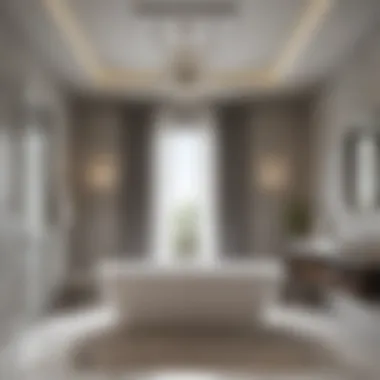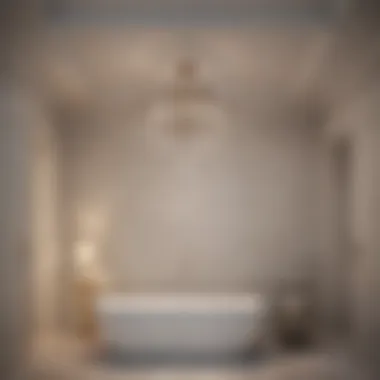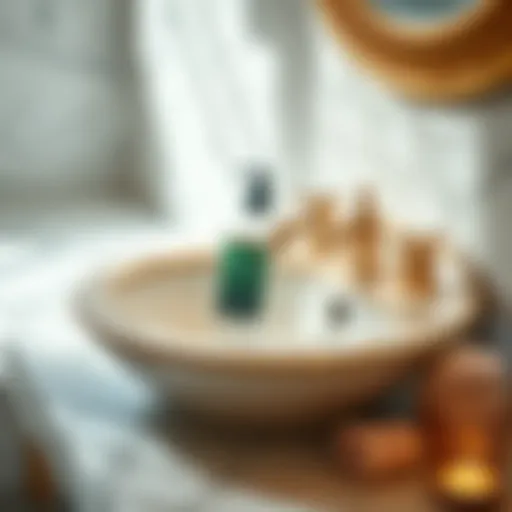Exploring Ceiling Bathtub Fillers: Design and Benefits


Intro
In the world of bathroom aesthetics and functionality, ceiling bathtub fillers have captured the attention of homeowners and design lovers alike. These fixtures not only add a dash of elegance to the bathing experience but also introduce a fresh perspective on utilitarian design. When one contemplates a bathroom renovation or upgrade, choosing the right bathtub filler can transform an ordinary space into a luxurious retreat. Elevating the overall vibe and making a statement is just the beginning.
The interplay of design, material, and functionality in ceiling bathtub fillers speaks volumes about contemporary trends. Not only do they offer innovative solutions for limited space, but they also enhance the overall visual narrative of a room. Understanding the categories of styles, color palettes, and styles further enriches one’s approach to selecting the perfect filler, ensuring it harmonizes with the surrounding decor.
As we embark on this exploration, let's take a closer look at how these batting fillers tie in with trending styles and color palettes, allowing us to infuse personality and sophistication into a seemingly simple bathroom element.
Understanding Ceiling Bathtub Fillers
Ceiling bathtub fillers occupy a remarkable niche in modern bathroom design. Beyond mere functionality, they weave a narrative of elegance and practicality within the bathing experience. The importance of grasping the nuances of ceiling bathtub fillers lies not only in their aesthetic appeal but also in the benefits they bring to how we interact with our bathing spaces.
These fixtures stand tall, literally and figuratively, highlighting the interplay between art and utility. When homeowners consider a renovation or a new bathroom installation, the ceiling filler’s role often becomes central to both form and function. They can transform a mundane routine into an experience that feels luxurious and opulent.
Definition and Purpose
A ceiling bathtub filler can be defined as a freestanding fixture that delivers water directly into the bathtub from above, eliminating the need for traditional faucets mounted on the tub or wall. This unique configuration allows for greater flexibility in the design and positioning of the bathtub itself. The primary purpose here is functionality - ensuring that water flows smoothly into the tub. However, it also serves as a focal point in the bathroom, contributing to an overall aesthetic that reflects the homeowner's taste.
Interestingly, ceiling fillers are not just about appearance or convenience. They often accommodate varied bathtub shapes and sizes, making them ideal for both compact areas and expansive spaces. This versatility enhances their appeal among design enthusiasts who seek to combine practicality with artistic expression.
Historical Use and Evolution
Historically, the idea of filling bathtubs from the ceiling was rather non-existent, as traditional designs relied heavily on wall-mounted or deck-mounted taps. However, as bathroom design evolved through the decades, so did the fixtures we use.
In the early 20th century, bathrooms were primarily utilitarian spaces. Designers focused on functionality, sidelining aesthetics. With the rise of the home improvement trend in the 1960s and 70s, homeowners started demanding more personalized and appealing elements in their bathrooms. This led to creative experimentation with layouts and fixtures.
Fast forward to today, and ceiling bathtub fillers are becoming more popular. They draw influence from minimalistic designs often seen in contemporary homes. The open spaces they create not only enhance the elegance of the bathroom but also allow easier cleaning and maintenance. Homeowners have noticed that these ceiling-mounted fillers, while sometimes seen as a luxury, are increasingly practical, bringing a fresh perspective on how we use and view our bathing spaces.
The evolution continues as innovations bring forward smart technology and eco-friendly materials. Buyers are now making choices that consider both aesthetics and environmental impact. These trends further outline the importance of understanding ceiling bathtub fillers as part of the broader conversation on contemporary bathroom design.
Design Considerations
When we talk about ceiling bathtub fillers, the design considerations play a pivotal role in ensuring that these fixtures not only serve their functional purposes but also complement the overall aesthetic of a bathroom. Choosing the right design is akin to finding a missing piece in a puzzle; it enhances both the appearance of the space and the user experience. From the materials employed to the style variations available, there’s a wealth of thought that should go into selecting the right ceiling bathtub filler.
Aesthetic Integration with Bathroom Design
A ceiling bathtub filler can either make a space sing or fall flat. Its look needs to mesh seamlessly with the existing bathroom décor. This means considering the room's theme, color palette, and style elements. For instance, if your bathroom has a rustic charm with wooden accents, a filler made from warm brass or copper might just be the cherry on top.
In practical terms, the right design not only brings the eyes up—highlighting your bathtub for all its glory—but also contributes to a vibe of tranquility and luxury. Fixtures shouldn't look like they just tumbled in from a different planet; they should feel like a natural extension of the space.
Choosing the Right Material
Materials are the backbone of any good design. When selecting a ceiling bathtub filler, the material can drastically alter its aesthetic and functional qualities. Let’s delve into some popular choices:
Copper
Copper has been around for quite some time, and there’s a good reason for that. The distinctive reddish-brown hue lends an authentic character to the bathroom. Its natural antimicrobial properties are a huge plus, ensuring a more hygienic bathing experience. However, this beauty comes at a cost—literally. Copper is often pricier and may require more upkeep to prevent tarnishing. The vibrant patina it develops over time can be considered its unique feature, giving it a distinctive vintage charm, though some folks may find the maintenance a tad daunting.
Brass
Brass is another contender in this arena. Its gold-like quality presents an opulent feel without quite the financial hit of pure gold. What sets brass apart is its durability and resistance to corrosion, making it an ideal metarial for wet environments. One notable feature is that it can be polished to a shine or left to develop its natural oxidation—both of which cater to different design preferences. However, some users may find that brass can tarnish and rub off in high-use areas, requiring occasional cleaning to maintain that shining allure.
Stainless Steel
If durability is of concern, stainless steel generally steals the show. It is as tough as nails and requires minimal maintenance. This metal looks sleek and modern, easily fitting in with various contemporary designs. Plus, its resistance to rust makes it a safe bet for any bathroom. However, one downside is that it may not provide the warm, inviting aesthetic found in copper or brass. It sticks firmly to a more utilitarian vibe; thus, it might not be the first choice for those aiming for a traditional look.


Plastic
Now, plastic may seem like a no-brainer choice for budget-conscious homeowners. Lightweight and relatively inexpensive, plastic fills a necessary niche but often lacks the character or visual appeal of metals. Some models even come in various colors, providing a quirky touch. On the flip side, its longevity and resistance to wear might be concerning; most plastic fixtures may not hold up as well over time compared to their metal counterparts.
Style Variations
The world of ceiling bathtub fillers also offers a buffet of styles to choose from, each adding a different flavor to your space:
Contemporary
Contemporary designs are all about simplicity and function. With clean lines and sleek finishes, they elegantly fit into today’s modern bathrooms. These fixtures often focus on blending in rather than standing out, ensuring that they complement other elements in the room without overwhelming them. It’s a style that feels right at home in minimalist or ultra-modern spaces but may lack the character needed in more eclectic homes.
Modern
Modern styles take a slightly different approach; they emphasize bold statements and unique shapes. Here, you might find striking silhouettes or adventurous finishes that stood out in a crowd. Such designs add a dash of personality to the bathroom, often becoming conversation starters, though they might not suit every homeowner's taste.
Vintage
For those who lean towards nostalgia, vintage styles often echo the charm of yesteryears. These fixtures might have intricate designs or antiqued finishes that transport one back in time. However, while they imbue a warm, inviting spirit to a room, they might come with challenges such as increased maintenance or the need for sourcing compatible fittings.
Minimalist
And then there are minimalist designs. Stripped down to the essentials, they often sport a no-nonsense appearance that promotes tranquility. Great for slowing down the hustle and bustle of modern life, minimalist fillers often provide just what you need and nothing more. Still, their simplicity can sometimes border on starkness, lacking the warmth that other styles might exude.
Understanding these design considerations adds depth to your decision-making process for selecting ceiling bathtub fillers. Getting it right can lead to a cohesive, inviting space that enhances your bathing experience.
Functional Benefits of Ceiling Fillers
When it comes to bathroom fixtures, ceiling bathtub fillers may not always be at the forefront of our minds. However, their functional benefits are worth exploring. These fixtures provide unique advantages that can elevate one's bathing experience, particularly for households that value both style and practicality.
Space Efficiency
In bathrooms, where space is often at a premium, every square inch counts. Ceiling fillers offer a remarkable solution to the common problem of limited space. Traditional bathtub faucets can sometimes obstruct movement or clutter the aesthetic of a well-designed bathroom. By utilizing ceiling-mounted options, homeowners can enjoy a cleaner and more open look. This approach not only maximizes the available area around the tub, it also opens up more design possibilities.
Moreover, ceiling fillers help in reducing excess elements that can make a bathroom feel congested. They can be located strategically to allow for easy access to hot and cold water while maintaining a streamlined appearance. This makes the bathroom feel larger and more cohesive, giving off an air of sophistication.
To highlight this benefit:
"A well-placed ceiling faucet can create a more spacious and fluid layout, simplifying both design and movement."
Ease of Use and Accessibility
Functionality should never be underestimated when selecting bathroom accessories. Ceiling bathtub fillers are designed to make the bathing experience as easy as pie. With a simple pull of a lever or turn of a knob, homeowners can control water flow with great ease.
Adults and children alike find these fixtures more user-friendly than standard wall-mounted taps. They can be particularly beneficial for individuals with mobility challenges. Rather than bending down or reaching awkwardly to fill a tub, a ceiling-mounted spout presents a more accessible option. This allows bathers to fill the tub without contorting their bodies, making for a more comfortable experience overall.
In addition, these fixtures often come equipped with innovative technology such as adjustable spray patterns or temperature control systems. Such features not only enhance the ease of use but also provide an added level of customization, allowing for a more personalized bathing experience.
Here are some benefits of ease of use and accessibility:
- User-friendly operation – Controls are typically within easy reach.
- Ideal for everyone – Children and elderly users can manage with less strain.
- Customizable settings – Advanced options for water temperature and flow.
Putting functionality in the frame, ceiling bathtub fillers are not just about filling a tub; they’re about enriching the entire bathing experience.
Installation Insights


Installing a ceiling bathtub filler is not just a matter of slapping it on the ceiling and calling it a day. It’s an art and a science, combining structural considerations with aesthetic desires. The installation process is a crucial step to ensure that the fixture functions properly and enhances the overall bathroom experience. Getting this step right can mean the difference between a stunning bathroom feature and a plumbing nightmare.
Pre-Installation Considerations
Before diving into the actual installation, it is imperative to consider a couple of key factors that will make the experience smoother.
Plumbing Requirements
One cannot overstate the importance of plumbing requirements when it comes to installing a ceiling bathtub filler. Proper plumbing ensures a steady water flow, reducing the likelihood of future leaks. When everything's set up correctly, the water pressure remains consistent. This is crucial for a satisfying fill during baths. A unique feature of this requirement is that it often necessitates the expertise of a licensed plumber, making it a popular choice for homeowners who value quality work over DIY attempts. The downside is the added cost, but the peace of mind that comes with proper installation far outweighs this.
Ceiling Height Adjustments
The height of your ceiling can make or break the effectiveness of a ceiling bathtub filler. Ceiling height adjustments are vital for optimal performance, ensuring the fixture is at a comfortably reachable level. A unique advantage of this consideration is that it offers flexibility in design; you can enhance the visual appeal while maintaining functionality. On the flip side, if heights aren't adjusted properly before installation, you might find yourself wrestling with awkward angles or even unusable fixtures. It’s this complexity that makes understanding ceiling height adjustments so beneficial in this article.
Step-by-Step Installation Guide
To assist you through the installation process, we present a clear, step-by-step guide that simplifies the task of fitting your ceiling bathtub filler.
Preparing the Area
Before installation kicks off, preparing the area is non-negotiable. A clean, clutter-free space allows for smoother progress, which significantly reduces the chances of mistakes. This step not only involves clearing any surrounding objects but might also require the use of drop cloths to protect flooring if you're dealing with water. A unique feature of this preparatory stage is the opportunity to inspect for any plumbing issues beforehand, providing a chance to fix problems before they escalate. Remember, an ounce of prevention is worth a pound of cure.
Securing the Fixture
Once the area is ready, the next step is to secure the fixture. Properly securing the fixture ensures that it remains stable during use, preventing it from becoming a hazard. This process is essential; it involves the right tools and techniques to ensure everything is in its place. One of the advantages of this step is that it allows homeowners to customize their fixture positioning, which not only applies to aesthetics but also to functionality.
A stable fixture means fewer headaches in the long run.
However, if incorrect installation occurs, it could lead to leakage or, worse, detachments that can cause water damage—a nightmare for any homeowner.
In summation, these installation insights are designed to empower you through the process, ensuring that every component is thoughtfully considered before you take the plunge into using your ceiling bathtub filler.
Maintenance and Troubleshooting
Maintaining your ceiling bathtub filler is crucial not just for its aesthetic appeal but for ensuring long-term functionality and efficiency. Understanding the common issues that may arise helps in mitigating potential challenges before they escalate into costly repairs. Failure to address maintenance can lead to reduced performance and could turn your tranquil bathing experience into a frustrating ordeal. Proper troubleshooting ensures that you make the most of your fixture while also avoiding unnecessary expenses.
Common Issues and Fixes
Leaks
Leaks are probably one of the most common issues that homeowners face with ceiling bathtub fillers. The source of leaks can often be traced back to faulty connections or deteriorated seals. It's not just an annoying drip; a leak can contribute to water wastage, mold growth, and eventually structural damage if ignored. Addressing leaks promptly is essential for maintaining the integrity of your bathroom space.
Key characteristics of leaks include:
- Location: Can occur at various connection points, like where the supply lines meet the fixture.
- Assessment: Regularly inspect for signs of water accumulation or dampness around the filler.
Unique feature of leaks is their ability to escalate issues quickly. If a minor leak is left unattended, it could morph into a more serious plumbing nightmare. Advantages of early detection mean you can fix the problem with minimal disruption rather than having to consider major repairs later on.
Low Water Pressure
Low water pressure can be another major headache when it comes to ceiling fillers. It impacts the overall efficiency of the appliance and turns what could be a refreshing bathing experience into a frustrating wait.
The key characteristic of low water pressure is often identified by a weak or inconsistent flow from the spout. Understanding potential causes—such as clogged pipes, incorrect pipe sizing, or issues in the municipal supply—can lead you to the right solutions.
Low water pressure can be a beneficial indication of underlying plumbing issues that require immediate attention. If the water pressure remains low over time, it could lead to sediment build-up within the pipes, making it harder for water to flow. The unique feature of addressing this issue promptly is that you may discover other plumbing deficiencies that need tackling, ensuring a holistic approach to your bathroom's plumbing health.


Routine Maintenance Tips
To keep your ceiling bathtub filler running smoothly, consider these routine maintenance tips:
- Inspect for leaks regularly—monthly checks can save a lot of hassle. Look for water spots on ceilings or walls.
- Clean the spout and filters to ensure unobstructed water flow. Build-up can lead to reduced pressure over time.
- Check for mineral deposits if you live in an area with hard water. Cleaning these especially around connections can prevent significant problems.
- Apply lubricant to moving parts to keep them functioning smoothly, as this can prevent wear and tear.
- Regularly assess surrounding fixtures since changes in other bathroom elements, such as faucets or pipes, can affect your ceiling filler.
Incorporating these maintenance practices into your routine will not only enhance the longevity of your ceiling bathtub filler but will also ensure that your bathing experience remains a soothing escape.
Future Trends in Bathing Fixtures
As we step further into the 21st century, the realm of bathing fixtures is undergoing a palpable transformation. Ceiling bathtub fillers, in particular, are becoming focal points not just for functionality but aesthetics. Understanding future trends in this area is essential for homeowners and design enthusiasts, as these trends often reflect shifts in consumer behavior, sustainability, and technology. As we venture into the depths of innovation, we need to grasp how features can enhance the bathing experience while also aligning with broader environmental considerations.
Technological Advancements
Smart Features
Smart features in ceiling bathtub fillers grip the attention of modern homeowners. These fixtures often boast automated controls and remote connectivity, enabling users to adjust water temperature, flow rate, and even lighting—all from their smartphones or through voice command features integrated with smart home systems.
One of the standout characteristics of smart technology is its ability to pre-heat water. This ensures an enjoyable soak right from the moment the tub is filled, removing the waiting game that often frustrates bathers. Furthermore, these automatic systems can sync with personal schedules, filling the tub while you wind down from a long day, effectively enhancing the overall bathing experience.
While the advancement of technology undoubtedly brings about comfort and convenience, a few considerations cannot be brushed aside. For instance, the reliance on electricity raises concerns about risks should there be power outages or malfunctions. Furthermore, the initial cost of such installations can deter some. Still, for those willing to invest, the long-term benefits often overshadow these drawbacks.
Water Efficiency Technologies
Water efficiency technologies have taken center stage, particularly given the increasing emphasis on environmental sustainability. These innovations in ceiling bathtub fillers are designed to reduce water consumption without sacrificing performance. Low-flow aerators and pressure balance systems are prime examples, enriching the water flow experience while minimizing waste.
The primary characteristic that makes water-efficient systems appealing is their ability to conserve resources. With many homeowners increasingly mindful of their ecological footprint, choosing a bathtub filler that captures these efficiencies resonates well with this audience. In the context of this article, such technologies mark an important step toward fostering a more responsible approach to home design.
However, potential buyers should also be aware of a few pitfalls. Implementing efficiency measures may require adjustments in existing plumbing systems, which could lead to additional costs. There may also be a period of adjustment for users accustomed to traditional water flow. Balancing these considerations with the desire for sustainability, it's clear that water efficiency technologies embody a pivotal trend in the future landscape of bathing fixtures.
Sustainable Materials
As the spotlight on eco-friendly living grows, sustainable materials in ceiling bathtub fillers are making significant headway. Homeowners are becoming more discerning about the materials they select, favoring options that not only last longer but also contribute to a healthier planet. Materials like recycled metals, bamboo, and biodegradable composites are gaining traction.
The major draw of these sustainable materials is their reduced environmental impact. By opting for products made from recycled or renewable materials, consumers can help minimize landfill waste and lower carbon footprints. This trend aligns with a larger movement within design communities toward creating spaces that reflect a commitment to preservation and responsible consumption.
Moreover, sustainable materials can often boast durability and unique aesthetic traits, challenging the notion that eco-friendly equals plain or unattractive. However, it's essential for buyers to understand that they may still encounter price premiums on these advanced materials compared to their conventional counterparts—an important factor to weigh when making a purchase decision.
In summary, the future of ceiling bathtub fillers points toward a harmonious blend of technology, efficiency, and sustainability. These trends not only serve functional needs but also resonate with the increasing desire for homes that reflect modern values and progressive thinking.
Epilogue
When considering ceiling bathtub fillers, the closing reflections in this article highlight the intricacies and multiple dimensions that surround these fixtures. They play a vital role not just in functionality but also in enhancing the overall aesthetic and ambiance of a bathroom. With an eye towards the future, understanding these elements equips homeowners and design enthusiasts alike to make informed choices.
Summary of Key Insights
In summation, the journey through the realm of ceiling bathtub fillers has revealed several crucial insights:
- Space Efficiency: These fixtures offer a unique opportunity to optimize space, making bathrooms feel more open and less cluttered.
- Material Variety: The availability of materials such as copper, brass, stainless steel, and plastic allows for personalized choices that align with individual tastes and budget constraints.
- Design Integration: Selecting styles that complement the existing bathroom decor does not just enhance beauty but can elevate functionality as well.
- Maintenance Necessities: Awareness of common issues, such as leaks and low water pressure, coupled with routine maintenance strategies ensures longevity.
- Future Trends: Embracing technological advancements like smart features presents opportunities for an enhanced bathing experience that caters to modern demands.
Each of these insights contributes to a more profound understanding of ceiling bathtub fillers, serving as building blocks for informed decision-making.
Encouragement for Exploration
As we wrap up this discussion, there's an invitation extended to all homeowners and design aficionados: dive deeper into the world of ceiling bathtub fillers. Experimenting with diverse materials and styles can unlock unexpected aesthetics and functionalities for your bathroom.
Consider aspects like:
- Personal Style: Your bathroom is a reflection of your personality; don’t shy away from exploring unique designs that suit your taste.
- Innovative Technologies: With advancements like water-saving features and smart controls, the options are numerous and often transformative.
- Budget Considerations: High-end doesn’t always mean better; research and choose wisely to find a balance between cost and quality.
Remember, each small change can have a significant impact on your bathing experience, transforming the ordinary into the extraordinary.















